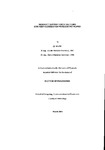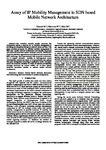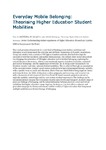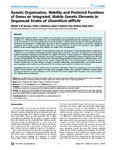MOBILITY SUPPORT ARCHITECTURES FOR NEXT-GENERATION WIRELESS NETWORKS
| dc.contributor.author | WANG, Ql | |
| dc.contributor.other | Faculty of Science and Engineering | en_US |
| dc.date.accessioned | 2013-10-08T09:24:09Z | |
| dc.date.available | 2013-10-08T09:24:09Z | |
| dc.date.issued | 2006 | |
| dc.identifier | NOT AVAILABLE | en_US |
| dc.identifier.uri | http://hdl.handle.net/10026.1/2078 | |
| dc.description.abstract |
With the convergence of the wireless networks and the Internet and the booming demand for multimedia applications, the next-generation (beyond the third generation, or B3G) wireless systems are expected to be all IP-based and provide real-time and non-real-time mobile services anywhere and anytime. Powerful and efficient mobility support is thus the key enabler to fulfil such an attractive vision by supporting various mobility scenarios. This thesis contributes to this interesting while challenging topic. After a literature review on mobility support architectures and protocols, the thesis starts presenting our contributions with a generic multi-layer mobility support framework, which provides a general approach to meet the challenges of handling comprehensive mobility issues. The cross-layer design methodology is introduced to coordinate the protocol layers for optimised system design. Particularly, a flexible and efficient cross-layer signalling scheme is proposed for interlayer interactions. The proposed generic framework is then narrowed down with several fundamental building blocks identified to be focused on as follows. As widely adopted, we assume that the IP-based access networks are organised into administrative domains, which are inter-connected through a global IP-based wired core network. For a mobile user who roams from one domain to another, macro (inter-domain) mobility management should be in place for global location tracking and effective handoff support for both real-time and non-real-lime applications. Mobile IP (MIP) and the Session Initiation Protocol (SIP) are being adopted as the two dominant standard-based macro-mobility architectures, each of which has mobility entities and messages in its own right. The work explores the joint optimisations and interactions of MIP and SIP when utilising the complementary power of both protocols. Two distinctive integrated MIP-SIP architectures are designed and evaluated, compared with their hybrid alternatives and other approaches. The overall analytical and simulation results shown significant performance improvements in terms of cost-efficiency, among other metrics. Subsequently, for the micro (intra-domain) mobility scenario where a mobile user moves across IP subnets within a domain, a micro mobility management architecture is needed to support fast handoffs and constrain signalling messaging loads incurred by intra-domain movements within the domain. The Hierarchical MIPv6 (HMIPv6) and the Fast Handovers for MIPv6 (FMIPv6) protocols are selected to fulfil the design requirements. The work proposes enhancements to these protocols and combines them in an optimised way. resulting in notably improved performances in contrast to a number of alternative approaches. | en_US |
| dc.language.iso | en | en_US |
| dc.publisher | University of Plymouth | en_US |
| dc.subject | Mobility Support (Management), | en_US |
| dc.subject | Macro Mobility, | en_US |
| dc.subject | Micro Mobility, | en_US |
| dc.subject | Mobile IP, | en_US |
| dc.subject | Session Initiation Protocol, | en_US |
| dc.subject | Quality of Service, | en_US |
| dc.subject | Next-Generation Wireless Networks | en_US |
| dc.title | MOBILITY SUPPORT ARCHITECTURES FOR NEXT-GENERATION WIRELESS NETWORKS | en_US |
| dc.type | Thesis | |
| plymouth.version | Full version | en_US |
| dc.identifier.doi | http://dx.doi.org/10.24382/3263 |
Files in this item
This item appears in the following Collection(s)
-
01 Research Theses Main Collection
Research Theses Main





